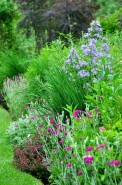Preservation philosophy
I have been fortunate to work with garden owners and community activists who won’t stand for these exceptional gardens to be lost. Gardens of such personal expression are most threatened by gradual decline in their owner’s ability to maintain the garden and by the lack of an appropriate organization to assume its ownership and management. Although there are plentiful examples of gardens that have been “preserved” to death, many more have slipped away because there was no way for their creators to pass them on to an organization with the vision and resources to sustain them.
Our understanding of what makes gardens important and what is involved in keeping them alive is always evolving. One of the biggest challenges is finding and training gardeners who are artists and plantsmen in their own right, who understand a creator’s philosophy as well as the site and its plants, but who are not afraid to experiment to keep the garden fresh and interesting. The framework of the garden will remain but will develop in new directions, the painting of the picture becoming more important that its completion. We most succeed when we match the next generation of gardeners with the exceptional gardens of today.
Documenting a garden is important so its new stewards can understand the creators’ original design intent for the garden and how it might continue to evolve. There are a number of ways of going about this: recorded, written and videotaped histories, plant inventories, garden plans and images cataloged.
An organization with a well-defined mission about the role of the garden in the community is essential. This is where I believe I have the most to contribute: to help an organization define its mission, to develop management capability to maintain its excellence, and to find the resources to sustain it and provide a sense of purpose for the common good.
Gardens come about through a long-standing and committed engagement with a piece of land, with its particular constraints and possibilities. These continually change and flow following the creator’s passions and personal experience, refinement of plantings, and the subtle regional and cultural expressions such gardens come to represent. Gardens are personal aesthetic visions, cultural expressions more dependent on collaboration with the natural world than any other art form.
To those who love gardens there is nothing quite so thrilling as seeing a good garden grow better over time. We become better gardeners, and our lives are much enriched, by visiting gardens made by people of outstanding ability. We can learn to appreciate how a creator’s vision can both come into focus and then mellow over time.
One of the great gifts gardeners can make is to provide for their work to continue beyond their lifetime. While the original gardener may not live to see the garden as fully envisioned, others will benefit from its genius and structure. Succeeding generations can create exciting new compositions within the framework of the original.
Across the country there are many gardens that give voice to the regional and cultural expressions of a time and place and tell the stories of their individual creators. We have learned to respect and appreciate the estate gardens of history’s socially prominent, with landscapes crafted by acknowledged masters. But for many gardeners it is easier to draw inspiration and instruction from our fellow non-professionals. Engrained in the American spirit is the celebration of what a single individual can accomplish through creative drive and hard work.







